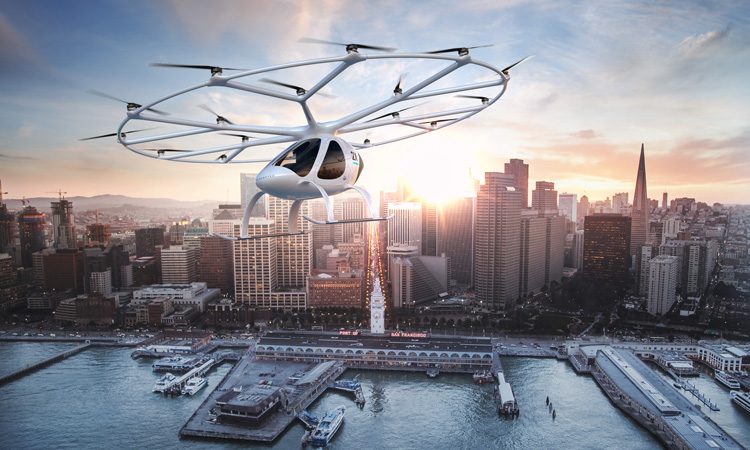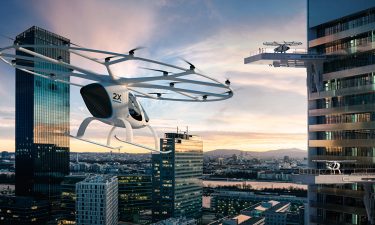Volocopter: shaping the future of urban air mobility
- Like
- Digg
- Del
- Tumblr
- VKontakte
- Buffer
- Love This
- Odnoklassniki
- Meneame
- Blogger
- Amazon
- Yahoo Mail
- Gmail
- AOL
- Newsvine
- HackerNews
- Evernote
- MySpace
- Mail.ru
- Viadeo
- Line
- Comments
- Yummly
- SMS
- Viber
- Telegram
- Subscribe
- Skype
- Facebook Messenger
- Kakao
- LiveJournal
- Yammer
- Edgar
- Fintel
- Mix
- Instapaper
- Copy Link
Posted: 17 August 2020 | Dr. Arnaud Coville - Volocopter | No comments yet
Recently appointed as the Chief Technical Officer of Volocopter, Dr. Arnaud Coville tells Intelligent Transport about the technology behind Volocopter and the regulation that comes with it.


When talking about urban air mobility, the primary concern for potential passengers is safety. What kind of technologies, either physical or digital, are in place to ensure that flights are safe?
The European Union Aviation Safety Agency (EASA) is the administration that is defining the rules and the safety levels for Urban Air Mobility (UAM). Their highest priority is the safety of passengers.
The EASA has defined rules for UAM that are more stringent than those that apply for large airplanes or helicopters. EASA’s reason for these higher safety standards is that air taxis will be flying over densely populated areas and the quantity of air taxis flying might exceed the number of airplanes.
In order to meet these safety levels, we use well-established safety driven design processes (like the ARP 4754) and apply them to our VoloCity design. These safety driven processes lead to high redundancy in all flight critical systems, high level of failure detection, failure tolerance, and dissimilarity in the design to alleviate generic failure in components. The development process ensures that all the features are linked to requirements and each are tested to work properly and robustly at several stages of the project.
The safety considerations of course expand beyond just the aircraft
For the VoloCity, the most visible aspect of the redundancy are the rotors and motors. We have 18 of them. If we lose one or two, we can still fly and land safely. This concept extends to all parts of the VoloCity (batteries, flight control computers, air data and attitude sensor). Furthermore, we design functions of the VoloCity with two or three independent teams, so that as many people as possible take a fresh look at the functions. An issue that would be overseen by one team or in a product would be picked up by the others. The teams performing the testing are different than those designing the products, that nothing is overlooked during the testing.
The safety considerations of course expand beyond just the aircraft. A digitalised controlled air space covering the city – so called U-Space – will also play an integral part. This system ensures that all participant in the air traffic will be connected to one another and exchange important information on routes, the weather and each other’s status. Such systems already exist for aircrafts and helicopters; during our flight in Helsinki last summer, we successfully integrated with the international airport of Helsinki through such a system (video).
How is Volocopter developing systems for a brand new market like urban air mobility?
We are making the dream of electric flight in cities come true. This has never been done before, so there are several elements we have built from scratch – all the distributed electric propulsion and its flight control is completely new.
Unexpected events in airspace are significantly less frequent than those one must account for on the streets
We use the experience that we gained on the VC 200 and Volocopter 2X prototypes, with which we have performed over 1,000 flights. This is the basis for the specifications we defined for the VoloCity systems. Most of the systems are developed together with partners who are renowned players in the aviation world. We combine our innovative approaches to topics like the distributed propulsion and our partners’ extensive experience to create completely new systems that are both: extremely safe even to aviation standards and take advantage of new technology.
All in all, we keep on developing our offer in a stepwise approach that is prudent and safe.
How quickly does the company have to be able to adapt to solve new issues in testing?
We are constantly evolving and learning. This is a process that will never stop. As an engineer, there is no such thing as a finished project. You can always improve and try new ways etc. Certainly, as a start-up and a passionate team, we are as flexible as it gets in aircraft testing. We think outside the box and find new ways to tackle new and old challenges.
You do have to bear in mind that we are a highly regulated industry – and rightfully so. And it is within the framework of an EASA certified Design Organisation that we continuously improve our product.
The company launched its VoloPort concept last year – what kind of innovations will be brought to this to ensure it is fit for purpose in an urban environment?
The VoloPort was already designed with an urban environment in mind. When we built the first prototype in Singapore, we did so addressing all necessities for UAM operators, considering topics like battery charging, aircraft maintenance, fire department as well as a state-of-the-art customer experience. Here too a big part of the innovation will come from fully digitalised processes.
Volocopter’s multicopters are fully electric – how important is it for the company to ensure it is using the latest battery and charging technology – and techniques – to ensure efficient operation?
This is a key aspect in our business model. We are looking for the most modern and efficient solutions available on the market to increase battery lifetime. That being said, and circling back to your very first question, safety is always our number one concern. And in a regulated industry you are required to work with certified partners in every step of the process. So, there are limits to how far we can go, but we are pushing innovation as far as is possible.
Data and connectivity are at the heart of modern mobility operations – how do these elements factor into air mobility? (e.g. V2X technology, personalised information services, data capture and insights)


Data and connectivity will play an even bigger role, once autonomous flight becomes feasible.Even within the Urban Air Mobility System, data and connectivity will be a crucial enabler allowing us to know our fleet status, learn demand, and plan flight paths. We will monitor the status of the aircrafts, the batteries, motors, and many other components of the VoloCity making sure that operations and maintenance are optimised. Furthermore, the data will deliver insights for the design improvements. Digitalisation is omnipresent in making air taxis a reality.
How do you see the urban air mobility market developing with regards to unmanned, autonomous vehicles?
It is the holy grail. At Volocopter we have a whole team working on autonomous flight topics. There are two key drivers for pushing towards autonomous flight:
- It increases safety. (Most accidents in aviation are caused by human error)
- It makes the business case for air taxis more attractive.
We are part of several working groups on the topic and the EASA is also very interested in autonomous flight, especially from the safety point of view. Automated flight is already omnipresent in aviation for certain parts of any flight mission.
At Volocopter, for example, we have conducted successful testflights of automated take-off, landing and cruise. This means an “uneventful” flight can already be done without a problem. The challenge remains with unexpected events during flight. Those are the cases we are developing and testing our autonomous systems for. And this is why we are convinced that we will see autonomous flying way before autonomous driving.
Unexpected events in airspace are significantly less frequent than those one must account for on the streets: No children playing, no overlapping road markings, or road signs hidden behind a tree in spring… you get the idea.
Autonomous flight will come, but it will come in steps. Slowly and surely, one aspect after the other of flying will be automated and eventually become autonomous.
Biography
Dr. Arnaud Coville holds a PhD in automation technology and robotics and has nearly thirty years of experience in the aviation industry. Coville played a key role in the development of aircraft from helicopters (H135), regional jets (RJ700 and 728) to large airliners (A350 and A380) at companies such as Safran, Fairchild Dornier, Diehl and Airbus Helicopter.
Related topics
Connected & Autonomous Vehicles, Infrastructure & Urban Planning, Intelligent Transport Systems (ITS), Mobility Services, Transport Governance & Policy, Vehicle & Passenger Safety
Related modes
Air taxi, Autonomous vehicles
Related organisations
European Union Aviation Safety Agency (EASA), VoloCopter







